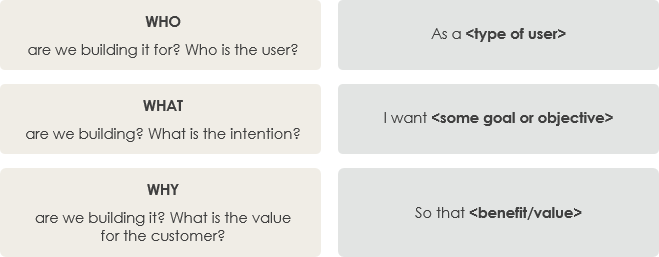مفهوم داستانهای کاربر
داستانهای کاربرروش سبکی برای به سرعت ثبت کردن «چه کسی»، «چه چیزی» و «چرا» نیازهای محصول است. به سادگی، داستانهای کاربر ایدههایی هستند که نیازهایی را که کاربران دارند بیان میکنند. داستانهای کاربر کوتاه هستند و هر عنصر معمولاً کمتر از ۱۰ یا ۱۵ کلمه دارد. داستانهای کاربر لیستهای «باید انجام شود» هستند که به شما کمک میکنند مراحل را در مسیر پروژه شناسایی کنید. آنها کمک میکنند تا اطمینان حاصل شود که فرآیند شما و محصول نهایی، نیازهای شما را برآورده میکند.

مفهوم این نوع چیزها را دوست دارم بگویم راهی برای درک و توضیح کلمه؛
داستان کاربر = کاربر + داستان = شخص + داستان + رویداد
یعنی، چه چیزی یک شخص میخواهد انجام دهد و به چه دلیلی، سه عنصر اصلی که باید استخراج شوند، چه کسی، چرا و چه چیزی است. از منظر کاربر، این یک توصیف کوتاه است که برای تأیید کاربر و نیازهای او استفاده میشود.
سه عنصر داستان کاربر
داستانهای کاربر در فرآیند توسعه نرمافزار به عنوان شکلی از بیان برای توصیف نیازها استفاده میشوند. به منظور استانداردسازی بیان داستانهای کاربر و تسهیل ارتباط، داستانهای کاربر معمولاً در فرمت زیر بیان میشوند:

به عنوان یک <نقش کاربر>، میخواهم <فعالیت را کامل کنم> تا <ارزش را تحقق بخشم>.
یک داستان کاربر کاملداستان کاربرشامل سه عنصر است.

- شخصیت (چه کسی؟): چه کسی میخواهد از این استفاده کند
- عمل (چه چیزی؟): چه عملی باید انجام شود
- ارزش: (چرا؟) این کار را انجام دهید و چه ارزشی میتواند با انجام این کار به دست آید
سه اصل ۳C
اطلاعات توصیفی داستانهای کاربر به صورت سنتی و با دست بر روی کارتهای کاغذی نوشته میشود، بنابراین ران جفریس (۲۰۰۱) این سه جنبه را ۳C مینامد:
- کارت (Cارد)،
- گفتگو (Cانورسیشن) و
- تأیید (Cانفیرمیشن).

کارت:داستانهای کاربر معمولاً بر روی کارتهای کوچک با توصیف کوتاهی از داستان، قوانین و معیارهای تکمیل نوشته میشوند.
جلوی کارت شامل توصیف داستان به فرمت: به عنوان یک <نقش>، میخواهم <فعالیت را کامل کنم> تا <ارزش را تحقق بخشم> نیاز را توصیف کند؛ پشت کارت شامل قوانین و معیارهای تکمیل برای تکمیل داستان کاربر به فرمت: فرض کنید…زمانی که…سپس است.
گفتگو: جزئیات پشت داستان کاربر از ارتباط با مشتری یا مالک محصول ناشی میشود؛ اطمینان حاصل کنید که همه طرفها داستان را به درستی درک کنند.
تأیید:تأیید کنید که داستان کاربر به درستی از طریق آزمون پذیرش تکمیل شده است.
- نوشتن داستانهای کاربر عمومی
- نقشهبرداری داستان کاربر چیست؟
- چگونه داستانهای کاربر را با نقشه داستان مدیریت کنیم؟
- اولویتبندی داستانهای کاربر
This post is also available in Deutsch, English, Español, Français, Bahasa Indonesia, 日本語, Polski, Portuguese, Ру́сский, Việt Nam, 简体中文 and 繁體中文.













